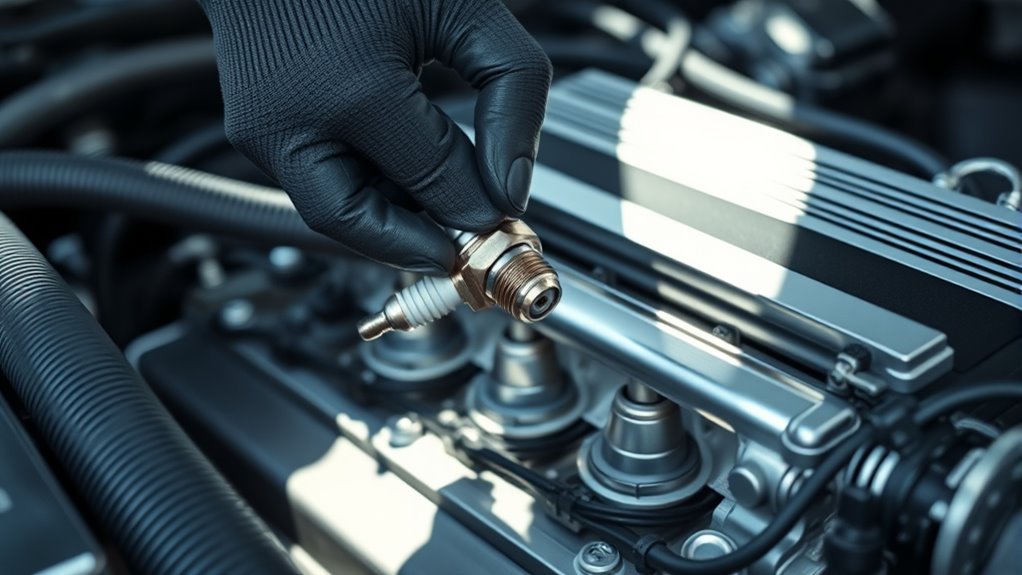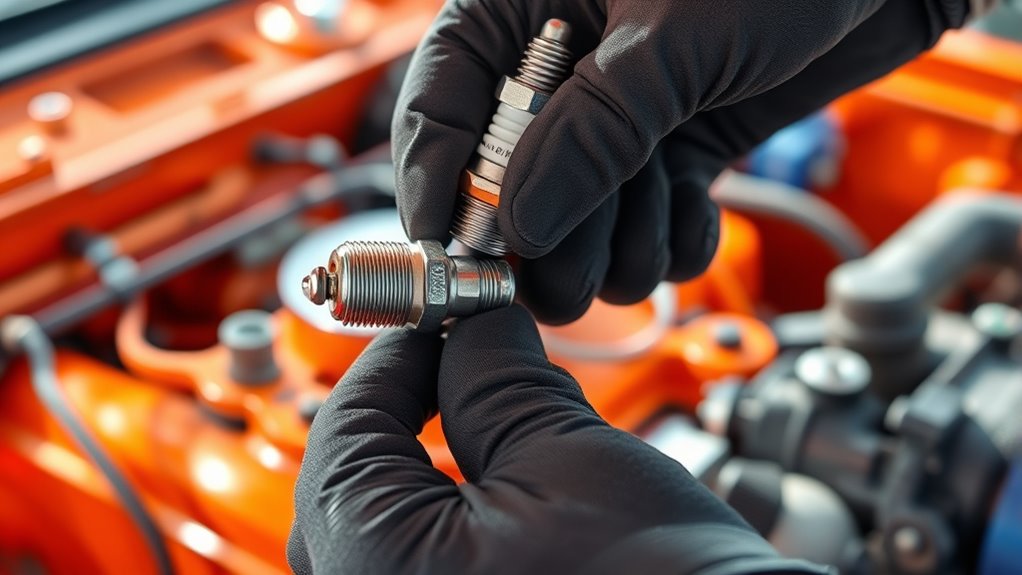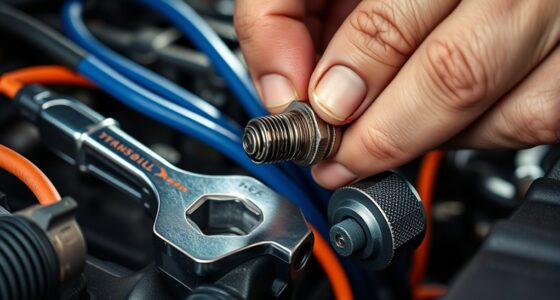Replacing your spark plugs is a simple task that can boost your vehicle’s performance and fuel efficiency. First, verify the engine is cool and locate the spark plugs. Carefully disconnect the ignition wires, remove the old plugs, and check their condition. Adjust the gap on new plugs as needed, then install them snugly without over-tightening. Reconnect the wires securely, start your engine, and enjoy smoother operation. Keep going to learn all the steps for a successful spark plug change!
Key Takeaways
- Gather necessary tools, ensure engine is cool, and locate spark plugs before beginning removal.
- Carefully disconnect ignition wires, then remove old spark plugs using a socket wrench.
- Inspect and adjust the gap of new spark plugs according to manufacturer specifications.
- Install new spark plugs by hand, tighten with a wrench, and reconnect ignition wires properly.
- Start the engine to verify smooth operation, and perform final checks for secure connections.

Have you ever wondered how to keep your engine running smoothly? One of the key components that directly influence your vehicle’s performance is the spark plugs. They’re essential for igniting the fuel-air mixture in your engine’s cylinders, which makes the ignition system work effectively. When spark plugs become worn or dirty, your engine’s performance can suffer, leading to rough idling, poor acceleration, or decreased fuel efficiency. Changing your spark plugs is a straightforward task that you can do yourself, saving money and guaranteeing your engine runs at its best.
Keeping your engine smooth with simple spark plug maintenance boosts performance and longevity.
To start, you’ll need the right tools—usually a socket wrench, a spark plug socket, a gap gauge, and possibly a torque wrench. Before you begin, make sure your engine is cool to avoid burns or damaging the components. Locate the spark plugs; they are typically positioned along the top or side of the engine, connected to thick wires or ignition coils. Carefully disconnect the ignition wires or coils, noting their placement so you can reconnect them correctly later. Use the socket wrench with the spark plug socket to loosen and remove each spark plug. When removing them, do so gently to prevent damaging the ceramic insulator or the threads in the cylinder head.
Once the old spark plugs are out, inspect them closely. If they look fouled, covered in carbon deposits, or have a worn electrode, it’s definitely time for replacements. Before installing new spark plugs, check their gap with a gap gauge—this assures proper ignition and peak engine performance. Adjust the gap according to your vehicle manufacturer’s specifications if needed. When installing the new plugs, carefully thread them by hand first to avoid cross-threading, then tighten them with your socket wrench. Don’t over-tighten—use a torque wrench if you have one, following the recommended torque settings to prevent damage. Proper tire pressure ensures optimal performance and safety for your vehicle.
Finally, reconnect the ignition wires or coils in their correct positions. Double-check everything to make sure the connections are tight and secure. Starting your engine afterward, listen for a steady idle and smooth operation. If you notice hesitation or rough running, revisit your work and ensure the spark plugs are properly gapped and tightened. Regularly changing your spark plugs not only boosts your engine’s performance but also prolongs its lifespan, keeping your vehicle running efficiently. It’s a simple maintenance step that has a big impact on your car’s reliability, and with a bit of effort, you can keep your engine firing on all cylinders.
Frequently Asked Questions
How Do I Identify the Right Spark Plugs for My Vehicle?
To identify the right spark plugs for your vehicle, start by checking your owner’s manual for recommended spark plug types and specifications. Look at your engine’s requirements to guarantee compatibility, considering factors like heat range and electrode design. You can also visit your local auto parts store or online retailer, input your vehicle details, and confirm the spark plug’s compatibility. This way, you’ll find the correct spark plugs for peak performance.
What Tools Are Essential for Changing Spark Plugs?
Think of changing spark plugs as repairing a delicate clock; you need the right tools to keep everything ticking smoothly. The tools needed include a spark plug socket, ratchet wrench, extension bar, and a torque wrench for proper tightening. Be aware of common mistakes like over-tightening or stripping threads. These tools help you avoid errors, making the process easier and ensuring your engine runs efficiently without damaging components.
How Often Should Spark Plugs Be Replaced?
You should replace your spark plugs based on their spark plug lifespan, which typically ranges from 30,000 to 50,000 miles. Check your vehicle’s owner manual for specific replacement intervals, as driving habits and conditions can affect this. Regular inspections help you catch wear early, ensuring smooth engine performance and fuel efficiency. Don’t wait too long; timely replacements prevent misfires and potential engine damage.
Can I Change Spark Plugs Without Removing the Engine Cover?
You can often change spark plugs without removing the engine cover, but it depends on your vehicle’s design. If the engine cover is in the way, you’ll need to do an engine cover removal to improve spark plug accessibility. Removing the cover is usually simple and gives you better access to the spark plugs, making the replacement easier and quicker. Always check your vehicle’s manual for specific instructions.
What Are Signs My Spark Plugs Need Replacement Sooner?
You might need to replace your spark plugs sooner if you notice signs of wear, like rough idling, difficulty starting, or decreased fuel efficiency. These signs indicate your spark plug lifespan is shortening, often due to buildup or erosion. Regularly inspecting your plugs and paying attention to performance issues helps catch wear early. Prompt replacement ensures smooth engine operation and prevents more costly repairs down the line.
Conclusion
With your new spark plugs in place, your engine will breathe easier, firing smoothly like a well-tuned orchestra. As you close the hood, imagine the engine purring to life, each spark igniting a symphony of power beneath your fingertips. You’ve transformed a simple task into a moment of mastery, ensuring your ride runs seamlessly. Now, every drive becomes a confident glide, a demonstration of your hands-on skill and the quiet promise of a journey ahead.








